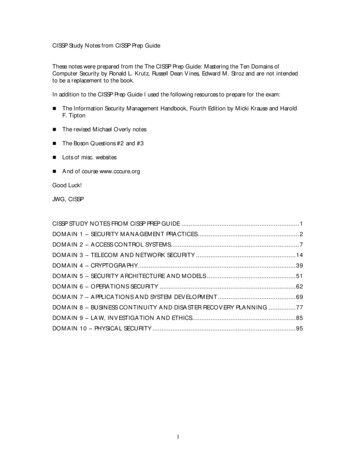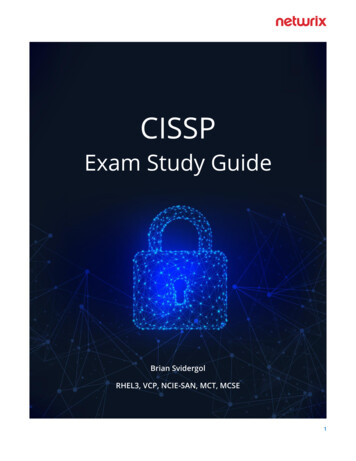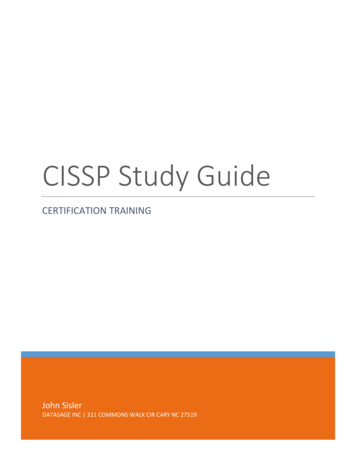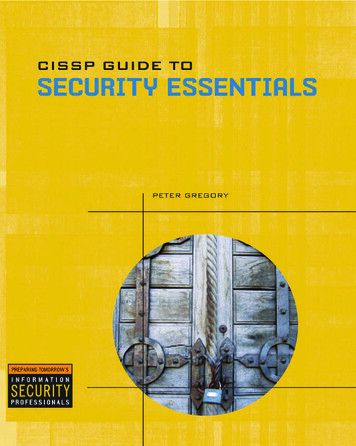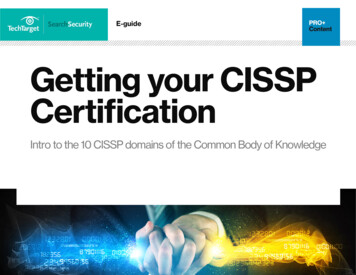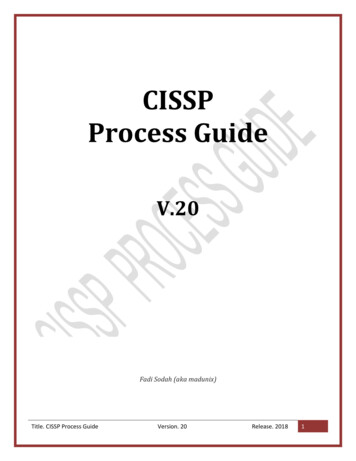
Transcription
CISSPProcess GuideV.20Fadi Sodah (aka madunix)Title. CISSP Process GuideVersion. 20Release. 20181
To benefit others with the knowledge and experienced I gained during my study term, I have summarized themain underlying concepts in a general overview. I am hoping this consolidation of core concepts andprocesses would benefit those interested in becoming members of the CISSP study group and the community.This document intends to be supplementary, not a replacement for officially published study guides and books.I may have added multiple definitions of the same process or procedure due to the varying definitions fromdifferent resources such as the Official CBK, Sybex, NIST publications, SANS papers, or the AIO Shon Harrisbooks. If you encounter any conflicts, please refer to the latest Official books CISSP CBK, AIO and Sybex. Beinga CISSP candidate, you should fully understand CISSP concepts, methodologies and their implementationswithin the organization.Please do not try any shortcut when it comes to reading books and gaining knowledge. This quick referenceshould be utilized as a fast recap of security concepts. It’s essential that you read Official CISSP books first andthen use these notes to get a recap of what you have learned. I wish you good luck for the CISSP exam.Fadi Sodah (aka madunix) CISSP CISA CFR ww.experts-exchange.com/members/madunixCISSP is registered certification marks of (ISC)², Inc.Discalamer: Fadi Sodah is not affiliated with or endorsed by (ISC)2If you find this document useful, please consider making a donation nationsTitle. CISSP Process GuideVersion. 20Release. 20182
Corporate Governance:Corporate governance is the set of responsibilities and practices exercised by the board andexecutive management with the goal of providing strategic direction, ensuring that objectives areachieved, ascertaining that risk is managed appropriately and verifying that the enterprise'sresources are used responsibly. Auditing supply chains Board and management structure and process Corporate responsibility and compliance Financial transparency and information disclosure Ownership structure and exercise of control rightsGovernance, Risk and Compliance (GRC):The process of how an organization manages its information resources. This process usuallyincludes all aspects of how decisions are made for that organization, such as policies, roles andprocedures the organization uses to make those decisions. It is designed to ensure the businessfocuses on core activities, clarifies who in the organization has the authority to make decisions,determines accountability for actions and responsibility for outcomes, and addresses howexpected performance will be evaluated.Areas of focus for IT Governance: Strategic alignment Value delivery Resource management Risk management Performance managementGovernance vs. Management: Oversight vs. Implementation Assigning authority vs. authorizing actions Enacting policy vs. enforcing Accountability vs. responsibility Strategic planning vs. project planning Resource allocation vs. resource utilizationNote: Governance: (What do we need to accomplish). Governance typically focuses on thealignment of internal requirements, such as corporate policies, business objectives, and strategy.Management: (How)Security Policy: Define the scope Identify all assets Determine level of protection Determine personal responsibility Develop consequences for noncomplianceTitle. CISSP Process GuideVersion. 20Release. 20183
The importance of following Infosec standards:Creating and using common, proven practices is an important part of a successful informationsecurity program. Not only do standards support proactive management and efficient riskmitigation, adopting and consistently following a standard can bring additional benefits to anyorganization. TRUST & CONFIDENCE. When organizations obtain certifications that demonstrate compliance,they create a sense of trust and confidence among employees and third parties with whom theyinteract. BETTER RESULTS. When you speak the same jargon, results are more productive, effective, andcohesive. E.g., vendor assessments can be smoother and faster with a formal infosec program inplace. COMPETITIVE ADVANTAGE. Developing a formal infosec program and obtaining certificationboosts client and stakeholder confidence in how infosec risks are managed and aligned with theirown risk appetite. CORPORATE RESPONSIBILITY. Holding an infosec certification can help organizationsdemonstrate due diligence and due care, which are mandatory requirements for company officersand essential for mitigating corporate negligence.Note: Information security standards offer best practices and share expert information. Thesestandards allow organizations to adopt, tailor, and implement a valuable infosec program withouthaving to hire full time experts, reinventing the wheel, and learning by trial and error, which iscostly, time consuming and dangerous.Challenges of implementing and maintaining standards: Time: Implementing and maintaining information security standards is not a one-time project.Rather, it is a process that requires dedicated, qualified personnel, support from senior leadership,and continuous monitoring and improvement. A successful effort will require buy-in from theentire organization. Cost: Standards can be expensive to implement and just as costly to maintain. In the case of ISO27001, for example, in addition to the time and effort necessary to meet the standardrequirements, organizations must budget for annual audit fees, which can be substantial. Buy-in: Senior leadership buy-in and program ownership at the C-level are critical elements foran organization to deploy an information security program effectively. The information securityteam must share metrics, report the effectiveness of the program, and demonstrate its value andstrategic alignment with the organization’s business objectives to maintain senior leadershipsupport. Change management: In general, everyone appreciates the value of securing information until itrequires a change. Security teams implementing standards are challenged to strike a delicatebalance between security and convenience. Continuous improvement: Standards have life cycles. When a standard is updated, it is theresponsibility of all compliant organizations to be aware of the updates and implement them byspecified dates, or as soon as possible if a time line is not mandated. In some cases, a standardmight become obsolete, and a new standard must be researched and presented to seniorleadership for approval for implementation.Title. CISSP Process GuideVersion. 20Release. 20184
Main security requirements and their subcomponents: Network Security Confidentiality Integrity Authenticity Availability Identity Management Authentication Authorization Accountability Revocation Privacy Data Privacy Anonymity Pseudonimity Unlinkability Trust Device Trust Entity Trust Data Trust Resilience Robustness against attacks Resilience against failuresRequired for accountability: Identification Authentication AuditingTitle. CISSP Process GuideVersion. 20Release. 20185
CIA: ConfidentialityRisk: The risk of privacy loss. Unauthorized disclosure.Control: Encryption. Authentication. Access Control. IntegrityRisk: Modified data by an unauthorized sourceControl: Access Control, Cryptography along with Hashing & Message Digests AvailabilityRisk: Unavailability of resources & information for authorized usersControl: Backups, High Availability, Fault Tolerance, Co-locationACID model: Atomicity -Is when all the parts of a transaction's execution are either all committed or all rolledback - do it all or not at all Consistency - Occurs when the database is transformed from one valid state to another validstate. A transaction is allowed only if it follows user-defined integrity constraints. Isolation - Is the process guaranteeing the results of a transaction are invisible to othertransactions until the transaction is complete. Durability- Ensures the results of a completed transaction are permanent and can survive futuresystem and media failures; that is, once they are done, they cannot be undone.Availability other concepts: Usability Accessibility Timeliness ReliabilityConfidentiality other concepts: Sensitivity Discretion Criticality Concealment Secrecy Privacy Seclusion IsolationSome of the techniques to ensure CIA are as follows: Process Isolation Software Confinement Bounds with limitations and restrictions Least Privileges PolicyTitle. CISSP Process GuideVersion. 20Release. 20186
DAD Triad: Disclosure—Reveal information and communications that are intended to be private andprotected. Alteration—Perform unauthorized modification of information, and introduce errors or defects. Denial—Cause systems to fail or perform poorly, and prevent authorized users from accessingthe data that they need.CIA-AP: Confidentiality: The capability of limiting information access and disclosure to authorized clientsonly. Integrity: The capability of preserving the structure and content of information resources. Availability: The capability of guaranteeing continuous access to data and resources byauthorized clients. Authenticity: The capability of ensuring that clients or objects are genuine. Privacy: The capability of protecting all information pertaining to the personal sphere of users.Access Control Review:The following is a review of the basic concepts in access control. Identification: Subjects supplying identification information Username, user ID, account number Authentication: Verifying the identification information Passphrase, PIN value, thumbprint, smart card, one-time password Authorization: Using the identity of the subject together with other criteria to make a determination ofoperations that a subject can carry out on objects “I know who you are, now what am I going to allow you to do?” Accountability: Audit logs and monitoring to track subject activities with objectsAuthorization approval procedure: Formalized Approval by the direct manager, data owner, security professional Access permissions follow the principle of least privilege Balance security with the need for access Avoid allowing too much privilege — Conflicts of interest Remove privilege when no longer neededDue Diligence vs. Due Care: Due Diligence - "Researching" -- Investigating and understanding risks Due Diligence – “Doing” all the necessary tasks required to maintain the due care Due Care - "Doing" -- Developing policies and procedures to address risk Due Care is to act responsiblyTitle. CISSP Process GuideVersion. 20Release. 20187
Data at Rest:The term data at rest refers to data that lives in external or auxiliary storage devices,such as hard disk drives (HDDs), solid-state drives (SSDs), optical discs (CD/DVD), or even onmagnetic tape. A challenge to protect the data in these states is, it is vulnerable, not only to threatactors attempting to reach it over our systems and networks but also to anyone who can gainphysical access to the device. Data protection strategies include secure access controls, thesegregation of duties, and the implementation of the need to know mechanisms for sensitive data.Data in Motion:Data in motion is data that is moving between computing nodes over a data network such as theInternet. This is possibly the most unsafe time for our data when it leaves the borders of ourprotected regions and ventures into that Wild West that is the Internet. Examples of in motiondata include e-mail, FTP, and messaging. Data protection strategies for data in motion include thefollowing: Secure login and session procedures for file transfer services. Encrypted sensitive data.Monitoring activities to capture and analyze the content to ensure that confidential or privacyrelated information is not transmitted to third parties or stored in publicly accessible file serverlocations. Use standard, robust encryption protocols. Use properly configured and up-to-dateSSL/TLS.Data in Use:Data in use refers to the information that is currently in use. It is used by staff, as in laptops orportable devices, and information that is being printed or copied to a USB stick. This is the dataavailable in endpoints. Data security controls for data in use would include port protection andwhole disk encryption. Controls against shoulder surfing, such as clear screen and clear deskpolicies, are also applicable to data in user controls.Security:Security is a continuous process, not a one-shot project. The security life cycle or the securitywheel is a continuous process that consists of several consequent phases (stages). The word cycleindicates the continuous and endless nature of such process. The ISO 27001 defines the cycle ofthe information security management system ISMS as PCDA: Plan-Do-Check-Act.Title. CISSP Process GuideVersion. 20Release. 20188
Samples of testing CIA Triad: Security Functionality: Verify that the software behaves according to requirements, whichshould include security. Fuzz-testing (or fuzzing): Enter a wide variety of out-of-range Dynamic Validation: Use variable data in the code to ensure the integrity of the software. Risk-Based Testing: Prioritize what features to test based on their potential risk and the impactof their failure. Penetration Testing: Play the role of an attacker, finding weaknesses and attempting exploits. Authentication Testing: Verify that communication over a network such as the Internet isprotected by secure identification methods. Regression Testing Confirm that newer patches, updates, and fixes work with older code.Considerations for Security Controls include: Accountability (can be held responsible) Auditability (can it be tested?) A trusted source (source is known) Independence (self-determining) Consistently applied Cost-effective Reliable Independence from other security controls (no overlap) Ease of use Automation Sustainable Secure Protects confidentiality, integrity, and availability of assets Can be “backed out” in the event of an issue Creates no additional issues during operation Leaves no residual data from its functionSecuring the Infrastructure:The internal information technology (IT) infrastructure must be secure before you can securelyextend IT into a cloud.Securing the Infrastructure Framework for Governance Risk Management The Security Program Data Protection System and Data Management Security Awareness Training User Provisioning Monitoring and Enforcement Incident ResponseTitle. CISSP Process GuideVersion. 20Release. 20189
Business Impact Assessment (BIA):A systematic process to determine and evaluate the potential effects of an interruption to criticalbusiness operations as a result of exploitation, disaster, accident or emergency.Key Metrics to establish BIA: SLO RPO MTD RTO WRT MTBF MTTR MORBusiness Impact Assessment: Identify Priorities Identify Risk Likelihood Assessment Impact Assessment Resource prioritizationNote: Risk can never be mitigated to zero (there is no such thing as “no risk” or “perfect security”)Business Impact Analysis: Identify critical functions Identify critical resources Calculate MTD for resources Identify threats Calculate risks Identify backup solutionsBusiness Impact Analysis: Select individuals to interview for data gathering Create data-gathering techniques Identify critical business functions Identify resources these functions depend upon Calculate how long these functions can survive without these resources Identify vulnerabilities and threats Calculate the risk for each different business function Document findings and report them to managementKey Performance Indicator KPI based on: BIA Effort to implement Reliability SensitivityNote: SLAs are often a subset of KPISecurity Programs Metrics: KPI looks backward at historical performance KRI looks forward, show how much risk exists that may jeopardize the future security of theorganization.Title. CISSP Process GuideVersion. 20Release. 201810
Business Continuity Planning (BCP): Project Initiation Business Impact Analysis Recovery Strategy Plan design and development Implementation Testing Continual MaintenanceBCP (NIST 800-34): Develop a planning policy; BIA Identify preventive controls Create contingency strategies Develop contingency plans Test MaintenanceWHY - Business Continuity Planning (BCP): Provide immediate and appropriate response to emergency situations Protect lives and ensure safety Reduce business impact Resume critical business functions Work with outside vendors and partners during the recovery period Reduce confusion during a crisis Ensure survivability of the business Get "up and running" quickly after a disasterDRP vs. BCP: BCP - Corrective Control DRP - Recovery Control Both BCP and DRP - fall under the category of Compensating Control BCP – is not a preventive control as it can NOT prevent a disaster BCP - helps in the continuity of organization function in the event of a disaster BCP - maintaining critical functions during a disruption of normal operations DRP - recovering to normal operations after a disruptionBusiness Continuity Planning (BCP): Continuity Policy Business Impact Assessment (BIA) Identify Preventive Controls Develop Recovery Strategies Develop BCP Exercise/Drill/Test Maintain BCPTitle. CISSP Process GuideVersion. 20Release. 201811
DR Team: Rescue Team: Responsible for dealing with the immediacy of the disaster –employee evacuation,crashing the server room, etc. Recovery Team: Responsible for getting the alternate facility up and running and restoring themost critical services first. Salvage Team: Responsible for the return of operations to the original or permanent facility(reconstitution) – (get us back to the stage of normalcy)Business Continuity Planning (BCP) Documents: Continuity of planning goals Statement of importance and statement of priorities Statement of Organizational responsibilities Statement of Urgency and Timing Risk assessment, Risk Acceptance, and Risk mitigation document Vital Records Program Emergency Response Guidelines Documentation for maintaining and testing the planDRP/BCP document plan should be: Created for an enterprise with individual functional managers responsible for plans specific totheir departments Copies of the plan should be kept in multiple locations Both Electronic and paper copies should be kept The plan should be distributed to those with a need to know Most employers will only see a small portion of the planTitle. CISSP Process GuideVersion. 20Release. 201812
Business Continuity Planning (BCP): Project scope and planning Business Organization Analysis BCP team selection Resource Requirements Legal and regulatory requirements Business impact assessment Identify priorities Risk Identification Likelihood Assessment Impact Assessment Resource Prioritization Continuity planning Strategy Development Provisions and Processes Plan Approval Plan Implementation Training and Education Approval and implementation Approval by senior management (APPROVAL) Creating an awareness of the plan enterprise-wide (AWARENESS) Maintenance of the plan, including updating when needed (MAINTENANCE) ImplementationDevelopment of Disaster Recovery Plan (DRP): Plan Scope and Objectives Business Recovery Organization (BRO) and Responsibilities (Recovery Team) Major Plan Components - format and structure Scenario to Execute Plan Escalation, Notification and Plan Activation Vital Records and Off-Site Storage Program Personnel Control Program Data Loss Limitations Plan AdministrationDisaster Recovery Plan (DRP) procedures: Respond to disaster by a pre-defined disaster level Assess damage and estimate time required to resume operations Perform salvage and repairTitle. CISSP Process GuideVersion. 20Release. 201813
Elements of Recovery Strategies: Business recovery strategy Focus on the recovery of business operations Facility & supply recovery strategy Focus on facility restoration and enable alternate recovery site(s) User recovery strategy Focus on people and accommodations Technical recovery strategy Focus on the recovery of IT services Data recovery strategy Focus on the recovery of information assetsThe eight R’s of a successful Recovery Plan: Reason for planning Recognition Reaction Recovery Restoration Return to Normal Rest and Relax Re-evaluate and Re-documentDisaster Recovery Program: Critical Application Assessment Backup Procedures Recovery Procedures Implementation Procedures Test Procedures Plan MaintenancePost-Incident Review:The purpose is how we get better; after a test or disaster has taken place: Focus on how to improve What should have happened? What should happen next? Not who s fault it was; this is not productiveContinuity Planning:Normally applies to the mission/business itself; Concerns the ability to continue critical functionsand processes during and after an emergency event.Title. CISSP Process GuideVersion. 20Release. 201814
Contingency Planning:Applies to information systems, and provides the steps needed to recover the operation of all orpart of the designated information system at an existing or new location in an emergency.Business Continuity Plan (BCP):BCP focuses on sustaining an organization's mission/business process during and after adisruption. It May be used for long-term recovery in conjunction with the COOP plan, allowing foradditional functions to come online as resources or time allows.Occupant Emergency Plan (OEP):It outlines first-response procedures for occupants of a facility in the event of a threat or incidentto the health and safety of the personnel, the environment, or property.Cyber Incident Response Planning (CIRP):It’s A type of plan that normally focuses on detection, response, and recovery to a computersecurity incident or event. It establishes procedures to address cyber-attacks against anorganization's information system(s).Information System Contingency Plan (ISCP):It provides established procedures for the assessment and recovery of a system following asystem disruption. Provides key information needed for system recovery, including roles andresponsibilities, inventory info, assessment procedures, detailed recovery procedures, and testingof a system.Continuity of Operations Plan (COOP):It focuses on restoring an organization's mission essential function of an alternate site andperforming those functions for up to 30 days before returning to normal operations.Disaster Recovery Plan (DRP):Applies to major physical disruptions to service that deny access to the primary facilityinfrastructure for an extended period. An information system-focused plan designed to restoreoperability of the target system, application, or computer facility infrastructure at an alternate siteafter an emergency. Only addresses information system disruptions that require relocation.Title. CISSP Process GuideVersion. 20Release. 201815
The risks to the organization found in: Financial Reputational RegulatoryRisk Analysis: Analyzing the environment for risks Creating a cost/benefit report for safeguards Evaluating threatElements of risk: Threats Assets Mitigating factorsRisk Analysis methodology: CRAMM (CCTA Risk Analysis and Management Method) FMEA (Failure modes and effect analysis methodology) FRAP (Facilitated Risk Analysis Process) OCTAVE (Operationally Critical Threat, Asset, and Vulnerability Evaluation) PUSH Spanning Tree Analysis SOMAP (Security Officers Management and Analysis Project) VAR (Value at risk)RMF CSIAAM: (NIST 800-37)The risk management framework (RMF) encompasses a broad range of activities to identify,control, and mitigate risks to an information system during the system development life cycle. Oneof the activities is the development of an ISCP. Implementing the risk management framework canprevent or reduce the likelihood of the threats and limit the consequences of risks. RMF include: Categorize the information system and the data Select an initial set of baseline security controls Implement the security controls and describe how the controls are employed Assess the security controls Authorize systems to be launched Monitor the security controlsRisk Management Process: (FARM) Framing risk Assessing risk Responding to risk Monitoring riskTitle. CISSP Process GuideVersion. 20Release. 201816
Risk management Policy Document: Objectives of the policy and rationale for managing risk Scope and charter of information risk management Links between the risk management policy and the organizations strategic and corporatebusiness plans-Extent and range of issues to which the policy applies Guidance on what is considered acceptable risk levels Risk management responsibilities Support expertise available to assist those responsible for managing risk Degree of documentation required for various risk-management related activities, e.g., changemanagement A plan for reviewing compliance with the risk management policy Incident and event severity levels Risk reporting and escalation procedures, format and frequencyRisk Management Life Cycle: Continuously monitoring Evaluating Assessing and reporting risk.Risk management: Risk Assessment — Risk Analysis — Risk Mitigation — Risk Monitoring —Identify Assets, Threats VulnerabilitiesValue of Potential RiskResponding to RiskRisk is foreverRisk management entails evaluating: Threats Vulnerabilities CountermeasuresMethodologies of Risk Assessment: Prepare for the assessment. Conduct the assessment: Identify threat sources and events. Identify vulnerabilities and predisposing conditions. Determine the likelihood of occurrence. Determine the magnitude of impact. Determine risk. Communicate results. Maintain assessment.Title. CISSP Process GuideVersion. 20Release. 201817
Preparing Risk Assessment: Purpose of the assessment The scope of the assessment Assumptions and constraints associated with the assessment Sources of information to be used as inputs to the assessment Risk model and analytic approachesRisk Assessment (NIST 800-30): System / Asst. Characterization Threat Identification Vulnerability Identification Control Analysis Likelihood Determination Impact Analysis Risk Determination Control Recommendations Results DocumentationKey Challenges in Third-Party Risk Management: Increases the complexity of third-party network & it's management Risk of failure to manage regulatory compliances Additional Cost for monitoring third-parties Lack of collaboration among parties Risk of information / data leakageKey Components of Third-Party Risk Management Framework:Following are the key components of Third-Party Risk Management (TPRM) Framework: Planning & process definition Segmentation & Screening Qualification Security & Permissions Workflows Risk Mitigation Continuous Monitoring Reports & Dashboard Centralized Repository Alert & NotificationTitle. CISSP Process GuideVersion. 20Release. 201818
Damage assessment: Determining the cause of the disaster is the first step of the damage assessment How long it will take to bring critical functions back online Identifying the resources that must be replaced immediately Declare a disasterDamage assessment: Determine the cause of the disaster. Determine the potential for further damage. Identify the affected business functions and areas. Identify the level of functionality for the critical resources. Identify the resources that must be replaced immediately. Estimate how long it will take to bring critical functions back online. If it will take longer than the previously estimated MTD values to restore operations, then adisaster should be declared and BCP should be put into action.Note: The first activity in every recovery plan is damage assessment, immediately followed by damagemitigation. The final step in a damage assessment is to declare a disaster. The decision to activate a disaster recovery plan is made after damage assessment andevaluation is completed.Title. CISSP Process GuideVersion. 20Release. 201819
Configuration Management: Plan Approve Baseline Implement Control Changes Monitor Report RepeatableConfiguration Management: Configuration Identification Configuration Control Configuration Status Accounting Configuration AuditChange Control: Implement changes in a monitored and orderly manner. Changes are always controlled Formalized testing Reversed/rollback Users are informed of changes before they occur to prevent loss of productivity. The effects of changes are systematically analyzed. The negative impact of changes in capabilities, functionality, performance Changes are reviewed and approved by a CAB (change approval board).Title. CISSP Process GuideVersion. 20Release. 201820
Change Management: Request for a change to take place Approval of the change Documentation of the change Tested and presented Implementation Report change to managementChange Management: Request Review Approve Schedule DocumentChange Management: Request Evaluate Test Rollback Approve Document Determine Change Window Implement Verify CloseTitle. CISSP Process GuideVersion. 20Release. 201821
Patch Management: Patch Information Sources Prioritization Scheduling Testing Installation Assessment Audit Consistency CompliancePatch Management: Evaluate Test Approve Deploy VerifyPatch Management: Inventory Allocate Resources Pursue updates Test Change Approval Deployment pla
CISSP Process Guide Version. 20 Release. 2018 2 To benefit others with the knowledge and experienced I gained during my study term, I have summa


